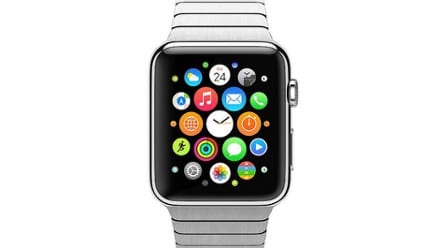
Image by Sumit Chauhan used under CC license.
Early this week, an app called Slice published a report stating the Apple Watch was “tanking” and likened the situation to the dramatic failure that was Google Glass. Apple Insider then countered the report by stating what it actually showed was that the device is completely dominating the smartwatch market.
No matter who you believe or what your stance on the Apple Watch is, this situation is a clear demonstration of how extremely volatile this emerging market is.
We thought that given the general uncertainty around wearables, it would be a good time to review the announcements made this year at Google I/O, Apple WWDC, E3 and Wearable World Congress – the events that lay out the game plan for the technology sector every spring. By their very nature, these events not only affect developers, but every industry that utilizes mobile software. Essentially, if your company has an app or is planning on creating one, pay attention.
Gestural Controls
Arguably one of the most exciting announcements this year was Google Soli, the new chip that allows wearables to use radar to sense tiny changes in the posture of our fingers. This new capability allows for extremely fine gesturing as demonstrated in the video below:
“You feel like a magician. It is clear that for us humans this idea of controlling something without a perceivable actuator brings us back to our childhood where we felt all powerful and ‘though’ that everything happened around us. The examples show this. The fingers quickly move and make something happen. Something goes, something appears,” says Rob van Kranenburg, founder of the Internet of Things European Council.
However, Google still has to work out some kinks, such as how to tailor each sensor to its user. Without this personalization, those with missing digits or motor-neuron diseases such as Multiple Schlerosis and Parkinson’s Disease, would be unable to use it. Though Soli is the first wearable-compatible model of gestural control, the concept has long been sought after and it can be argued companies like Myo have beat Google to the punch. That said, the fact that the new technology can be instantly integrated into Android products once it’s ready might negate that advantage. Google’s Android Wear is currently limited to wrist flicks in the realm of gestural control. The new system would allow for completely unique development opportunities.
Developers are already brainstorming how gestural control can be integrated into new applications. How can your brand experience improve with this new tool?
Mobile Payments
With the release of Android Pay, Google has officially begun a face off against Apple in the mobile payments space. And, in an attempt to volley, Apple has responded by expanding into Europe. Samsung is also joining the fray with LoopPay, which recently rolled out on the Samsung Galaxy 6. What this means for brands is they can now be fairly sure retailers will accept one or both options and the experience of paying for goods and services will change more drastically than it has since credit cards went mainstream
However, this isn’t the cakewalk for businesses that it may seem. In a recent CIO article, Al Sacco interviewed several financial executives including Angie Moody, vice president of product innovation, Capital One. Angie explained how one of the biggest threats to mobile payment success is knowing when you’re removing too much friction from the payment experience. “You have to balance reduction of friction with the need to make people understand the process,” Moody said. “People today spend money without even thinking about it. By removing friction, you take the customer away from the tangibility of cash.”
Making it too easy for users to spend money can cause some to go up in arms when they review their bank statements. A great example of this problem is Uber. The ride-hailing service recently implemented changes to its application that force users to confirm they understand they are accepting “surge” pricing rates which can run significantly higher than typical fares. This was done in an effort to retain users who were walking away from the company, feeling they had been cheated and taken advantage of.
Apple Watch Opens to Developers
The biggest announcement at Apple’s WWDC event was that the Apple Watch – after just two months of full consumer availability – would be changing operating systems. watchOS will not only feature more functionality for user, it will also feature an open and fully functional developer kit (commonly known as an SDK). This means that this fall, when the new SDK become available, the very first native apps for Apple Watch will be available.
Given the success of this device and the importance of its continued prosperity in the wake of Apple targeting global enterprises, native apps on the Apple Watch should be of extreme interest to any brand.
Virtual Reality
We had to save the biggest news for last. By far, the most groundbreaking announcements made this year were in the virtual reality space. While I/O and WWDC both had a fair share of exciting wearables updates, E3 was the real leader when it came to exciting virtual reality news.
The announcement that Oculus Rift, the most anticipated consumer-facing virtual reality headset ever developed, will be available for purchase early next year led the charge into future-tech at the conference. Developers and gamers rejoiced as new versions of favorite games were demoed – and the creative wheels of brands started turning.
While some of these devices rely on input from other controls (Oculus Rift uses gloves and other gaming devices while Recon Jet uses inputs similar to Google Glass, via a touchpad on the side), many of the professional-grade virtual reality headsets make fantastic use of the gestural controls previously described. One of the leaders in this space is Atheer Labs’ flagship Atheer AiR™ SmartGlasses.
Tim Moore, VP of marketing at Six-15, which produces a variety of wearables for security, public safety, medical and logistical professionals, told us he is most excited about the advancements in both virtual reality and augmented reality, especially when it comes to professional applications.
“These two areas are the money spot moving forward,” Moore said.
Regarding what he refers to as invisible tech, or wearables that are almost completely inconspicuous, except when in use, there seems to be a very bright future.
“We are seeing this in the smart eyewear area with lens technologies that are practically invisible and only serve as a slave to those who need it. An example is a police officer who only needs to see certain notifications, assisting directions and information to help him be safe and efficient,” Moore explained.
The End Game: User Experience Is The More Critical Than Ever
“Experts agree that millennials will determine what will be the next trend in wearables. But since they are a diverse and large group – there are several subsets within the category of millennials – it will be difficult to predict which wearable will speak to which groups the most,” explained Ashley Waters, in a recent article on PRSpeak.
Since this group is known primarily for the fickleness with which they choose their accessories, one of the biggest challenges for analysts is keeping up with the lifestyle changes of consumers who fully embrace the technology. As we become more connected with each new announcement, the immersiveness of applications will increase on an almost exponential level.
For example, think about when your mobile phone application crashes – it’s annoying, but will not exactly ruin your day. If your smartwatch crashes, you may miss an important notification as you’ll be trained to no longer check your watch, and will instead be accustomed to having information pushed to you. Now think about what a jarring experience it would be if you were in a brand’s virtual reality experience – perhaps a tour of a retail location – and the software crashed. This quick and simple thought exercise is enough to illustrate that the era of “glitchy,” bug-filled apps being brought to market without repercussions is coming to an end.
New technology is incredibly exciting and the possibilities for every industry are endless. However, be sure to tread lightly. As your brand is able to inch more and more into the everyday life of consumers, the penalties for error will become increasingly dire.


